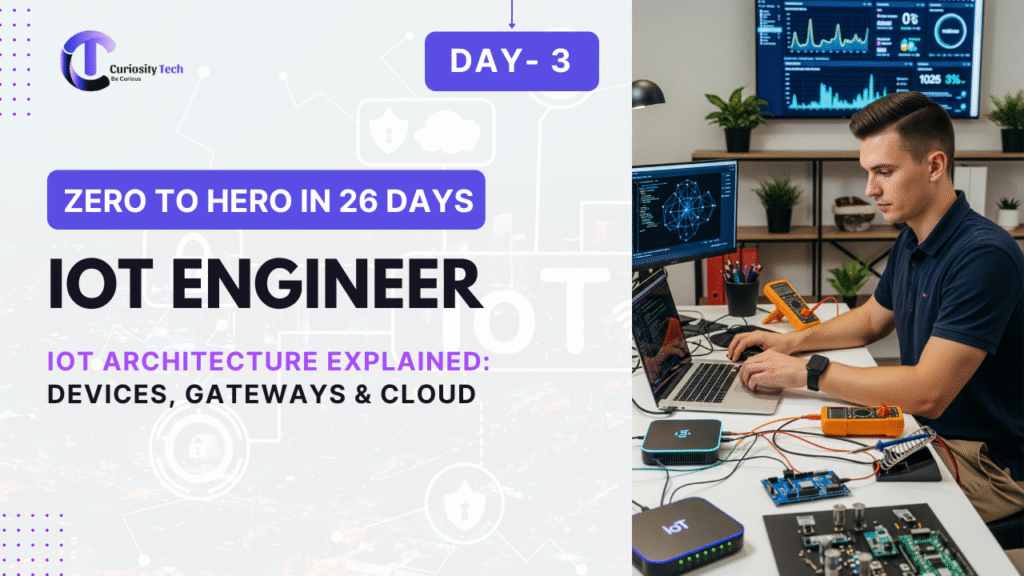When people first hear “IoT architecture,” they often imagine complex diagrams with arrows running in every direction — sensors here, cloud there, APIs somewhere in between. In reality, IoT architecture is elegant, layered, and surprisingly logical. Like city planning, it thrives on hierarchy and communication across levels: from small sensors in the soil to massive cloud data centers making real-time decisions.
As an engineer with 20 years in the field, I’ve built IoT architectures for factories, farms, and smart homes. To understand IoT deeply, you must understand its architecture because this blueprint defines scalability, reliability, and even security.
A City Analogy: Understanding Layers
Think of IoT as a city ecosystem:
- Devices = Citizens (sensors, actuators — the ones doing the work).
- Gateways = Roads & Bridges (networks carrying information).
- Cloud = Government & Data Centers (where information is processed and transformed into governance/policies).
- Applications = Services for Citizens (apps, dashboards, and automation that provide daily utilities).
Hierarchical IoT Architecture (Layered Breakdown)
To simplify, here’s how traditional IoT architecture is broken down:
1. Perception Layer (Device Layer)
- Who it is: Sensors, actuators, RFID tags, smart devices.
- Role: Collect data from the physical world (temperature, pressure, motion).
- Examples: Arduino-based sensor modules, smart thermostats, industrial machines with embedded sensors.
- Challenges: Power consumption, calibration, accurate data capture.
2. Network Layer (Connectivity Layer)
- Who it is: Gateways, routers, communication protocols.
- Role: Transfers data reliably from devices to servers/cloud.
- Technologies: Wi-Fi, Zigbee, Bluetooth Low Energy (BLE), LoRaWAN, Cellular IoT (NB‑IoT, LTE‑M).
- Challenges: Maintaining bandwidth, secure transmission, coverage in remote areas.
3. Edge Layer (Middleware & Gateways)
- Who it is: Edge servers, fog nodes, IoT gateways.
- Role: Filters, processes, or pre-analyzes data before sending it to the cloud.
- Example: A smart agriculture gateway that decides whether irrigation should trigger immediately instead of sending every sensor message to the cloud.
- Challenges: Balancing power vs. intelligence, integrating multiple device protocols.
4. Application Layer (Cloud & Visualizations)
- Who it is: Cloud IoT services (AWS IoT, Azure IoT Hub, Google Cloud IoT Core).
- Role: Aggregate and analyze data at scale, apply AI, provide dashboards/apps for decision-making.
- Output: Predictive analytics, alerts, dashboard visualizations, automation triggers.
- Challenges: Security, cost, latency, real-time scaling.
5. Business Layer (Services & Decisions)
- Who it is: End-user applications, enterprise integrations, policy-level decisions.
- Role: Make data useful for humans. For example, predictive maintenance alerts in factories or smart grids optimizing energy usage in real time.
Infographic Concept (IoT Architecture Stack)
Imagine a layered pyramid:
- Bottom: Devices Layer – dotted with thousands of sensors.
- Above: Network Layer – radio waves, LoRaWAN towers, Wi-Fi routers.
- Middle: Edge Gateways – mini servers filtering and compressing data.
- Next: Cloud Platforms – centralized hubs performing AI/analytics.
- Top: Application Layer – apps, dashboards, automation circuits feeding into business outcomes.
Such visuals help new learners see IoT architecture as a journey of data flow rather than isolated technologies.

Real-World Example: Smart Logistics
- Devices: GPS trackers and temperature sensors in trucks.
- Network: 5G / NB‑IoT mobile connectivity.
- Gateway: Edge routers inside vehicles check if conditions cross thresholds.
- Cloud: AWS IoT gathers millions of data points daily.
- Application: Logistics managers see dashboards in real-time, and AI models predict delays or failures.
- Business Outcome: Cost savings, efficient deliveries, improved customer trust.
This case shows how every layer contributes. Without devices, no data. Without networks, no transport. Without edge, no efficiency. Without cloud, no intelligence.
Tabular Breakdown: Roles of Each Component
| IoT Component | Function | Key Examples | Engineer’s Focus Area |
| Devices | Data collection | Sensors, actuators | Power efficiency, accuracy |
| Gateways/Edge | Pre-processing, protocol translation | Raspberry Pi, Intel IoT Gateway | Latency reduction, local AI |
| Cloud Platforms | Data aggregation & analytics | AWS, Azure, Google IoT | Scaling, APIs, policies |
| Applications | User interfaces & automation | Mobile apps, dashboards | UX, actionable insights |
Mistakes Beginners Make
From my mentoring sessions at CuriosityTech.in Nagpur, I notice beginners wrongly equate IoT architecture to “connect a sensor to the cloud.” That’s oversimplification. Without gateways and middleware, scaling 10 devices to 10,000 will collapse systems. Good engineers design architecture for resilience — redundancy, fallback networks, modular APIs. CuriosityTech’s hands-on lab simulations showcase these architectural stress tests to students.
Security in Architecture
IoT architecture must integrate security at every stage:
- Devices → unique IDs, secure boot.
- Network → encrypted protocols (TLS, DTLS).
- Edge → trusted hardware modules.
- Cloud → IAM (Identity Access Management), data encryption.
- Application → user access management.
This layered defense ensures hackers can’t exploit a single weak link.
Expert Path: Learning IoT Architecture
If you aim to be an IoT engineer in 2025:
- Start with device programming (Arduino, ESP32).
- Learn protocols (MQTT, CoAP, HTTP).
- Practice with gateways (Raspberry Pi running Node-RED or EdgeX Foundry).
- Deploy projects on cloud platforms.
- Build dashboards for visualization.
- Study case studies — from CuriosityTech IoT Labs where projects often progress from 5-node prototypes to industrial-level implementations.
Conclusion
IoT architecture may seem abstract, but once you understand it as a layered ecosystem of devices, connectivity, gateways, cloud, and applications, you see how every role in IoT engineering fits into the bigger picture. Each layer optimizes the stage before it, and only when all converge seamlessly does IoT become powerful: turning trillions of raw bits into actions that save energy, improve healthcare, secure cities, and enable insight-driven businesses.
This architectural mindset is what separates true IoT engineers from hobbyist tinkerers. With guidance, real projects, and structured training at ecosystems like CuriosityTech.in Nagpur, you can design not just “things” but entire IoT systems that work at scale in the real world.


